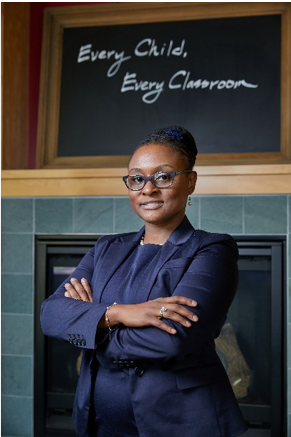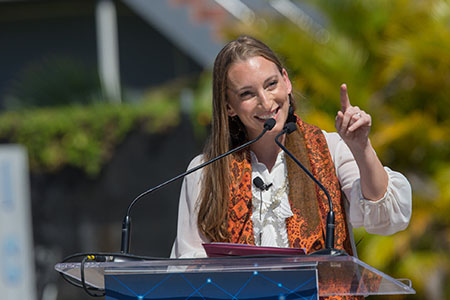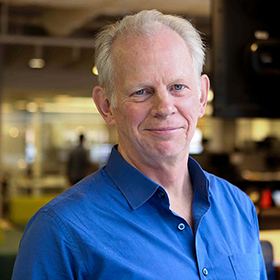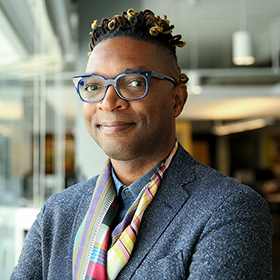When working with the public sector, place-based funders often play the role of “critical friend” in linking community-based organizations with municipal and regional authorities. They collaborate with elected officials and public administrators who are taking on the economic and social challenges in their regions. At the same time, they fund grassroots advocacy efforts to persuade those same leaders to repair the profound inequities that under-resourced, Black, Indigenous, and people of color (BIPOC) communities have long endured. All while realizing that any progress they might make could unravel with the next election cycle, as today’s partner could be replaced by an administration with a very different point of view.
“We need to support advocacy organizations that have the ability to push and demand change, to provide whatever resources they need to make their case,” said Carmen Randolph, vice president of programs at Greater New Orleans Foundation. “In addition to this grassroots investing, we have to work with the public sector itself—to educate them, to build relationships with public officials, and to elevate what community members are saying.”
Supporting local government through resources, collaborative initiatives, and pilots
Across the peer-learning cohort of 12 place-based funders who gathered in 2020, funders have collaborated with local and state governments on community-designed pilot programs that could be scaled. Initiatives in Atlanta, Houston, Miami, and Chicago reflect both the variety of private-public partnerships and the tradeoffs that can occur when working with the frenemy.
In Atlanta, when The Kendeda Fund works with the city’s public sector, it focuses on addressing the gap between what needs to happen and what can happen, in order to jumpstart initiatives that strengthen government and community partnerships. “We don’t insert ourselves into things that aren’t recommended by the community,” said Tené Traylor, Kendeda’s fund advisor.
For example, community organizers and parents’ groups had long pushed Atlanta’s school board to create a strategic equity plan to break through the barriers that have denied Black, brown, and low-income students an equal opportunity to succeed. The plan was hotly debated for more than a year. When it finally came out in 2020—just when a new superintendent arrived—another potentially contentious issue arose: who would execute it? That’s when Kendeda and two other funders—the Annie E. Casey Foundation’s Atlanta Civic Site and redefinED Atlanta—stepped in.
The three funders helped pay for the creation of the Atlanta Public Schools Center for Equity and Social Justice, which works to ensure that all students, particularly Black and Latinx students, have the resources and support to reach their full potential. The grants came with few strings attached, so administrators had “flexible support to make the office they needed to create,” said Traylor. The funders also paid for a chief equity and social justice officer, Tauheedah Baker-Jones, to run the center and be on point for rolling out the equity plan.
Kendeda’s work on the initiative was entirely behind the scenes. Its intent was to provide air cover for the new superintendent, so she wouldn’t have to fundraise for the center and also so she and the equity officer, with the community’s input, had sufficient space to innovate.
“Our job isn’t to pay for something the government can do,” said Traylor. “I think you use private money, when necessary, to support innovation. That’s what philanthropic capital can do. We foster innovation, even in rigid systems.”

In Houston, Houston Endowment similarly believes that when working with the public sector, especially in vast, less-than-flexible systems like urban public education, philanthropy is best positioned to foster innovation. “Our entire endowment equals the Houston Independent School District’s [HISD] one-year budget,” said Lisa Hall, Houston Endowment’s vice president of program strategy. “But we can be their risk fund for innovation. ‘What are you doing that’s scary, but if it works it can be game changing?’ We’re willing to fund it, as long as we think it’s a smart risk.”
One such smart risk was college counseling. For many years, Houston Endowment funded a post-secondary scholarship program for the region’s public high school graduates. Eventually, however, Houston Endowment recognized that not only did public dollars dwarf whatever it could contribute to scholarships for education beyond high school, there was just one college counselor for every 1,800 high school students across greater Houston—well in excess of the recommended 400:1 ratio. As a result, thousands of students were unaware of their post-secondary options, including make-or-break opportunities for financial aid and scholarships.
In 2015, Houston Endowment seized an opportunity to change the future for many Houston high schoolers, by providing funding to create a district-wide approach to using data and enhanced staffing, including hiring a dedicated college advisor for every high school campus. The sustained funding gave the college counselling system time to grow, demonstrate its promise, and get embedded across the Houston region’s sprawling school district. Eventually, the HISD school board incorporated the counselling system’s cost into its budget.
‘What are you doing that’s scary, but if it works it can be game changing?’ We’re willing to fund it, as long as we think it’s a smart risk.
In Miami, The Miami Foundation has also taken on the role of convincer (as well as convener), by working to ensure that a public-private initiative is such a game-changer in the lives of constituents that public officials embrace it, sustain it, and eventually shoulder all of the funding for it. At least, that is the hope behind Miami Connected, a public-private partnership that seeks to bridge the deep digital divide in Miami-Dade County, where more than one-in-five households lack an internet wireline or mobile data plan.
Miami is the second least-connected large city in the United States. “Digital disconnection will become a major driver of inequity in our community unless we do something about it,” declared Rebecca Fishman Lipsey, president and CEO of The Miami Foundation, and Sarah Emmons, who at the time was executive director of Achieve Miami, in a Miami Herald op-ed.[1]

This past March, The Miami Foundation, Achieve Miami, and other organizations from the public and private sectors came together to launch Miami Connected, which aims to provide internet connectivity, supplemented with digital literacy programs, for more than 100,000 under-served young people and families across Miami-Dade. The two-year effort commenced in two of the most disconnected areas in the county and will continue to prioritize schools and communities where the need is greatest.
“We must begin to treat internet connectivity as a fundamental right,” asserted Fishman Lipsey and Emmons. The larger goal, of course, is for universal Wi-Fi to not only become a right in the Miami region, but also a norm. If that happens, philanthropy will have helped create the conditions for the first green shoots of progress to emerge. But the public sector will have enabled those shoots to flourish. In collaborative work, it’s often best to let others get the credit, so long as the job gets done.
In Chicago, The Chicago Community Trust (The Trust) is both a partner with local and state government and a facilitator for bringing cross-sector actors together. “We have moved beyond just convening and exchanging ideas,” said Andrea Sáenz, The Trust’s chief operating officer. “We’re really hoping to help local governments achieve goals that are aligned with our goals.”
For example, The Trust has partnered with the State of Illinois on Healing Illinois, an initiative that promotes dialogue, collaboration, and facilitated learning to support communities as they work to repair the wounds wrought by systemic racism. Along with the Illinois Department of Human Services, The Trust manages the $4.5 million fund, which has thus far awarded grants to 179 organizations throughout the state. The Trust also coordinates Healing Illinois with the W.K. Kellogg Foundation’s Truth, Racial Healing & Transformation initiative, a national effort to reverse the insidious effects of racism. Further, they’ve engaged in partnerships with the city that require formal memoranda of understanding—“real partnerships with the country and with the state,” said Sáenz—such as a $50 million small business grant program that The Trust is administering.
At the same time, The Trust has also launched the Changemakers Network’s $1.5 million grant program, which supports the efforts of resident-led groups to build collective power and drive change at the neighborhood level. There won’t always be a meeting of the minds between the grassroots Changemakers and the elected officials that The Trust also works with. But partnering effectively with the government means managing the inevitable tradeoffs.
“It’s a balancing act,” said Sáenz. “We want to help local and state government achieve those goals that are aligned with our goals. But we are also advocates for things that the government needs to do better.”
Supporting—and sometimes pushing—policy change
In May 2020, the Center for Effective Philanthropy published a report underlining the philanthropic sector’s deep ambivalence toward influencing public policy. Its survey of private and community foundation leaders across the country found that on the one hand, 90 percent of them believed that philanthropy had an important role to play in influencing public policy. On the other hand, most of those interviewed described public policy engagement as “a small component of their overall efforts to achieve their goals.”
However, for the peer funders, policy change was not a “small component” of their work. Given the scale of the needs surfaced by the pandemic and the racial-justice crisis, many participants argued that the best use of their limited dollars was to fund advocacy efforts. “Last week eviction notices started, and there were grassroots advocates physically blocking landlords from coming into housing court,” said Takema M. Robinson of the Louisiana-based consultancy Converge for Change. “Given the scale of the problem, there isn’t a long-term investment we can make. Organizing and power-building is almost the only answer to the current crises. The only way to stop people from being evicted is organizing and advocacy work.”
We’ve also supported tried-and-true strategies, such as changing the narrative. We’re the most incarcerated place in the world. We didn’t have a Bill Gates-level budget. We needed to use the media to scale the message.
Another funder in New Orleans, Foundation for Louisiana’s Flozell Daniels, Jr., built on Robinson’s point. “Our grantmaking has been deeply steeped in supporting grassroots organizing, lifting people up so they can participate in policy making,” he said. “We’ve also supported tried-and- true strategies, such as changing the narrative. Lots of our narrative work came out of our Justice Reform work in 2017 in Louisiana. We’re the most incarcerated place in the world. We didn’t have a Bill Gates-level budget. We needed to use the media to scale the message. We hired a marketing and messaging firm. We spent less than $70,000 over 12 months to get op-eds, editorial board meetings, and laser-specific articles on violence in prison, women in prisons—issues that would touch hearts and minds.
{^widget|(path)%2fPersona-Widget-Content%2fRace-and-Place-based-Philanthropy%2f%2525|(name)BSG.PersonalizedCard|(tileposition)right|(widget_displayname)*+Personalized+Card|(width)|(height)^}“We put pressure on the folks making the decisions, so there was a message coming from faith leaders and libertarian conservative business people, wherever we could find lanes of narrative,” Daniels continued. “People shouldn’t be incarcerated because they are poor—that’s the message we went with. We were able to get that work done. We credit, in addition to on-the-ground advocacy, that online media approach—it made us look bigger than we were.”
For Ballmer Group’s Nina Revoyr, executive director of the organization’s Los Angeles program, the path to informing public policy begins with expanding the circle of who informs her and her colleagues. “Part of the work is staying in touch with advocacy organizations, including those we don’t fund,” she said. “That also includes community residents who aren’t in formal groups, but who give me insights into what’s happening on the ground. We can’t assume—and this is where philanthropy often falls short—that advocates and community organizers completely reflect the desires of all residents.”
New York City’s Robin Hood is taking a more direct approach to changing hearts, minds, and systems. Robin Hood has used its influence, as the largest poverty-fighting organization in New York City, to push policy makers to widen the aperture of their racial equity lens. It is well positioned to make a persuasive case, not least because its advocacy is deeply rooted in data.
For example, this past February, Robin Hood released its third annual Poverty Tracker report, which regularly surveys a cohort of 4,000 New York households, in partnership with Columbia University, to provide a dynamic view of poverty over time. Among its findings: in 2019, government transfers, such as unemployment benefits and refundable tax credits, reduced New York City’s overall poverty rate by 33 percent. Nevertheless, even accounting for those policies, the poverty rate among Black New Yorkers remained 83 percent higher than white New Yorkers, prior to the pandemic. The upshot of this good news meets bad news: with well-designed reforms, public policy could go a long way toward narrowing the poverty gap between New Yorkers of different races.
The Poverty Tracker’s data helped Robin Hood and its partners home in on an issue that could dramatically improve the lives of New York’s low-income families: the child tax credit, which reduces or even eliminates families’ tax burden. In March, drawing on the data it had collected, Robin Hood joined legislators and advocates in calling for a permanent expansion of the child tax credit in New York State. There was a palpable sense of urgency behind their advocacy, given that the federal American Rescue Plan—which experts predicted would otherwise cut child poverty by nearly 45 percent nationwide, albeit temporarily—excluded 72,000 children across New York State, especially those with an undocumented family member.
Said former Robin Hood CEO Wes Moore: “While the American Rescue Plan marks a tremendous step toward reducing childhood poverty across the country, it is not a failsafe method for New York families hit hard by the COVID-19 pandemic, as it excludes immigrant families—many of whom would benefit from this the most.” Even though many philanthropies are understandably reluctant to get anywhere near today’s pernicious political landscape, Robin Hood is one among those funders who understand they must sometimes do so, if they are to have any real shot at achieving their mission.
Questions for Reflection and Action
- How might you use your unique resources to better collaborate with your local government?
- Are there opportunities to fund specific government positions or agencies or to foster public sector innovation, for example, through pilots whose impact can then provide the confidence for deploying public dollars at scale?
- On the other hand, where might you pivot to the role of “frenemy,” by using your own voice and funding advocacy organizations to advance policies that support community priorities?
Where Might Race and Place-based Philanthropy Go from Here?
The peer-learning cohort of 12 place-based funders who shared their real-world knowledge across this series of five articles came together during one of the most tumultuous times in modern American history. A pandemic that infected millions of Americans and killed hundreds of thousands. The nation-spanning protests in the wake of George Floyd’s murder. The insurrection at the Capitol. The unavoidable evidence of deep, systemic racism, which once again boiled to the surface.Through it all, as the peer funders grappled with some of the fundamental questions that confronted so many place-based funders during that time of crisis (and will undoubtedly confront them in the crises yet to come), the participants surfaced dozens of tactics and practices for benefitting many more under-resourced communities. An array of new options, as well as those that are known to at least some other funders, is often what it takes to fuel renewal. Because, as Seattle Foundation’s Kris Hermanns put it, there is no such thing as a one-size-fits-all solution.
“There isn’t ‘an answer,’” said Hermanns. “Especially in a time that feels incredibly hard and raw, it’s really nice to try and find an answer. To have something that you can grasp. What’s helpful with this learning community is that you find your answers based on the wisdom and experience, and even f-bombs that people are willing to share. And you think about how you distill and translate that experience.”
This series is intended to be an entry point in keeping that conversation going. We hope you find something to apply to your work, something to help reframe a problem, or something to share—or even debate—with your colleagues. If you have a practice or insight to extend to the rest of us, please reach out to Debby Bielak, one of this paper’s co-authors ([email protected]). We will use your feedback as we figure out next steps for sharing what we’re learning about how place-based funders are leaning into more effective, more equitable philanthropy.
Debby Bielak and Darren Isom are partners in The Bridgespan Group’s San Francisco office. Marion Michieka is a senior associate consultant in the same office. Editorial Director Bill Breen is based in Bridgespan’s Boston office. The authors thank Bridgespan Senior Advisor Nan Stone for her guidance throughout this project.
Notes
[1] Rebecca Fishman Lipsey and Sarah Emmons, “COVID-19 exposed Miami’s digital divide. We’re working to close it--and we need your help,” Miami Herald, March 15, 2021.




